I LIKE Swindale because it???s not an easy place to find. It???s an even harder place to visit because parking???s not allowed in the valley. Outsiders are obliged to leave their cars on the common at the entrance because the road is so desperately narrow. I don???t like using the word ???remote??? because it is so often abused. St Kilda is remote. Terra del Fuego is remote. But if you want remote in a Lakeland context, then Swindale is as close as it gets . . .
 The farms ??? few that they are ??? have an only-just-made-it-into-the-1950s feel about them. I don???t mean this in a disparaging way. But run an observant eye over the sagging gutters, the waterlogged farmyards, the fading whitewash and the thin smoke trailing from bleak chimney stacks, and you get the impression that this is a place of dolly tubs, zinc baths, worn lino, thin curtains, Vim and Belfast sinks.
The farms ??? few that they are ??? have an only-just-made-it-into-the-1950s feel about them. I don???t mean this in a disparaging way. But run an observant eye over the sagging gutters, the waterlogged farmyards, the fading whitewash and the thin smoke trailing from bleak chimney stacks, and you get the impression that this is a place of dolly tubs, zinc baths, worn lino, thin curtains, Vim and Belfast sinks.
I could be quite wrong, of course. And no doubt one day some wiry-framed, flat-capped farmer with a Sun Valley roll-yer-own stuffed behind his lug will stumble on this website and give me a round of the kitchen floor from his laptop. All well and good. This is just the impression the place gives me. It says: listen to the rush of the wind in the branches and the bleating of sheep on the fell, and when you???re passing a parlour window, cock an ear to Alvar Lidell reading the evening news. We???ve invaded Suez, apparently.
Swindale is my sort of place. I discovered its charms quite recently. In fact, it was the day devastating floods swept through Carlisle ??? which I think was in 2005. It was horrendously wet in Swindale too. But I was struck by the earthiness of the place. If you want a Beatrix Potter, picture-postcard Lakeland with leaded-glass windows and geraniums on the sill, go to Ambleside or Grasmere. But if it???s a grittier Lakeland that appeals to the senses, one where the only splash of colour on a February morning is bed linen dancing on a farmhouse washing line, take a stroll through Swindale.
I have a three-point plan for today. One: follow the old corpse road that leads over the fells to Haweswater, but branch off to climb Selside Pike and Branstree, returning over High Wether Howe and the interestingly-named Outlaw Crag. Two: at the half-way point, drop down to Mosedale slate quarries and have a poke about. Three: I???ll come to this one later.
So at Swindale???s last farm I veer up the fell on the old corpse road to the crown of the moor. The wind is icy and thin; the turf has a crusty tundra feel about it. On the col between Selside Pike and Branstree I take pictures of a survey pillar that was built during the construction of Haweswater dam and its accompanying engineering and tunnelling works. It???s one of several that command strategic positions in this part of the Lakes.

 On Branstree I encounter the only other human of the day ??? a chap from Merseyside. He???s climbed from Longsleddale and over Harter Fell. We exchange a few words ??? not many ??? and I continue on my way, following a wall down the fell to the south then cutting across the lower slopes of Selside Pike to the quarries.
On Branstree I encounter the only other human of the day ??? a chap from Merseyside. He???s climbed from Longsleddale and over Harter Fell. We exchange a few words ??? not many ??? and I continue on my way, following a wall down the fell to the south then cutting across the lower slopes of Selside Pike to the quarries.

 Mosedale quarries ??? I could spend a summer???s day poking about in a place like this. Green slate was quarried here for many years, Mosedale Cottage ??? the MBA bothy at the foot of the fell ??? being the centre of operations. What immediately becomes apparent is that when the quarries were abandoned they were stripped of anything that could be sold, unlike the neighbouring Wrengill quarries, in Longsleddale, which are full of all sorts of interesting objects and scrap. In Mosedale, even the riving booths and crude quarry shelters have been stripped of their roofing slates ??? every single one of them ??? leaving only bare walls. I wander on across the valley, vaguely disappointed.
Mosedale quarries ??? I could spend a summer???s day poking about in a place like this. Green slate was quarried here for many years, Mosedale Cottage ??? the MBA bothy at the foot of the fell ??? being the centre of operations. What immediately becomes apparent is that when the quarries were abandoned they were stripped of anything that could be sold, unlike the neighbouring Wrengill quarries, in Longsleddale, which are full of all sorts of interesting objects and scrap. In Mosedale, even the riving booths and crude quarry shelters have been stripped of their roofing slates ??? every single one of them ??? leaving only bare walls. I wander on across the valley, vaguely disappointed.

Looking down from the top of the face in Mosedale quarries, with Mosedale Cottage MBA bothy at the foot of the fell
Point three of the three-point plan is to photograph an old railway goods wagon that sits on the ridge between Mosedale and Wet Sleddale ??? the valley of Withnail and I fame ??? which I have passed on several occasions over the years.
It has come to my notice, after several decades of walking through wild and desolate areas, that the wilder and more desolate the area becomes the more chance there is of stumbling across old railway goods wagons. It???s one of those unwritten laws. Doctor Beeching must have sold them all to farmers when he closed down the railways. I thought I???d start photographing them and perhaps set up a dedicated website.
I reach the crown of the ridge. The railway goods wagon is no longer there ??? but there is evidence of where it stood. Bugger. How can something as solid and as seemingly permanent as that suddenly disappear? Perhaps the farmer made a killing and sold it on for ten times what he paid Beeching. Perhaps one day I???ll see it hurtling through Darlington station.

 Disappointed a second time, I cross the boggy uplands to High Wether Howe and Outlaw Crag, then follow Haskew Beck down to the valley bottom in Swindale, where sheep still bleat and bed linen still dances on washing lines. Back at the car I boil a billy of tea, warm some homemade soup and turn on the crackly radio.
Disappointed a second time, I cross the boggy uplands to High Wether Howe and Outlaw Crag, then follow Haskew Beck down to the valley bottom in Swindale, where sheep still bleat and bed linen still dances on washing lines. Back at the car I boil a billy of tea, warm some homemade soup and turn on the crackly radio.
A voice from the past, one so quintessentially English, says: ???Here is the news ??? and this is Alvar Lidell reading it . . .???
Apparently soviet troops have invaded Hungary to prevent it breaking from the Warsaw Pact and Dwight D Eisenhower has been returned to the White House. There???ll be plenty to talk about in Swindale tonight.
- To hear Alvar Lidell reading a BBC news bulletin about German PoWs escaping into the Welsh hills, CLICK HERE then click on his picture.




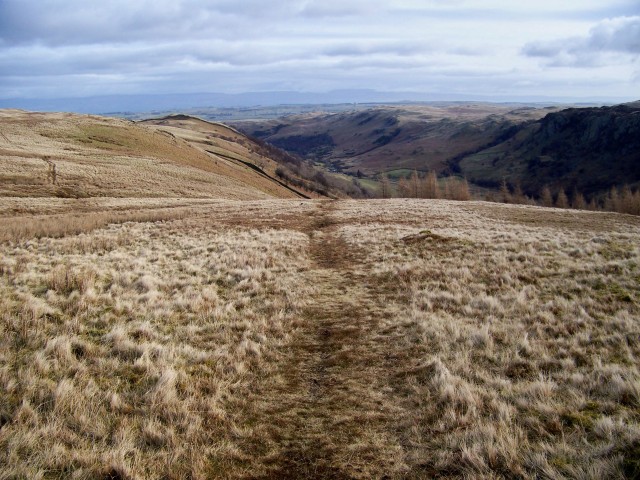
























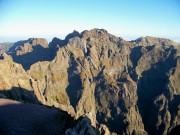

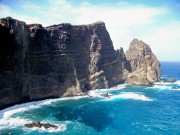
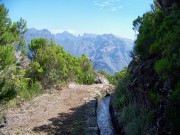
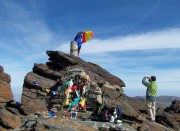

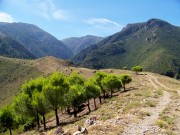
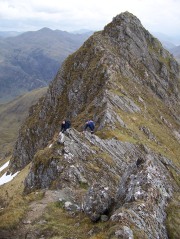
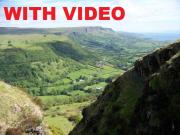
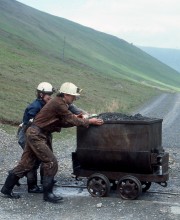
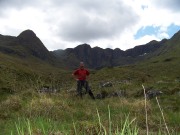

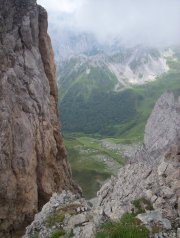
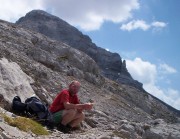
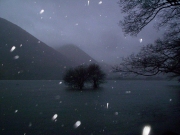
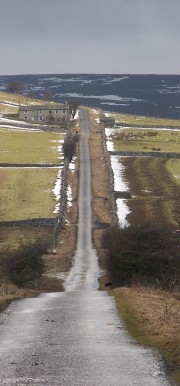

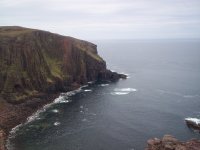
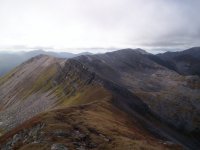
Swindale is a wonderful moody kind of valley and I can certainly appreciate why you return to it. I have not been there for years but used to go climbing up on Gouther Crag and can recall the timeless feel the valley had even now. The climbing guide writers (Reed and Ashton) also noticed the timeless nature in their introduction to the crag commenting that “Time and climbers seem to have passed by the gentle valley of Swindale”. I must admit I have never really thought about the railway wagons despite seeing them all over the moors. I suppose being made of wood most have begun to rot away. Reminds me of the one on the Pennine Way above High Force. Once over it was full of hay and you could shelter behind it and have your bait, now it’s full of holes and rotten.
You shouldn???t have mentioned the railway wagon above High Force because I???m going to have to go there now. Just from memory, I???ve a feeling I passed one or two last summer while cycling along that road from Langdon Beck over to St John???s Chapel, but I might be mistaken. I never have a camera with me when I see one. But yes, Swindale is a fine place. I was there back in November but the weather was so bad I abandoned the walk ??? which was the one I finally did here. I did manage to get some close-up photographs of a red squirrel, though, so it was worthwhile after all. I didn???t know Gouther Crag was climbing territory. I???d have paid more attention to it, because I dropped down to the valley right underneath it. Live and learn.
A great piece, how I wish I could I write with such ease!
Thanks Geoff. I wish I could have written it with ease too. I went through several drafts, several cans of beer and some sloe vodka (which isn???t quite ready yet but it tastes nice) before I rewrote the whole thing and finally got it ready for posting at about 1.30 this morning. And then I altered it again before I finally pushed the button. I’d tinker with it a bit more only I’m off to work soon.
Hi Alen, enjoyed the post, and followed you round via Memory Map.
When you start your “dedicated website to old railway goods wagons” I’ll post a few photos, and don’t forget the “Deluxe” the Guards Vans complete with stove and veranda, as for sighting towers you’ve spurred me to sort out some photo’s and post a new Blog —Cheers Danny
Hi Danny. I just knew that if somebody already had some photos of old railway goods wagons it would be you. Cheers.
Hi Alen,
You captured Swindale perfectly, I too have seen its bareness from from the Survey Pillars dotted about the Haweswater fells. I had plans to do the Wet Sleddale Horseshoe sometime in the near future and after reading your report It makes me wonder why I keep putting it off, maybe now I wont.
Bleak is beutiful & Swindale is Bleak.
Paul.
Hi Paul. I love that area of the fells, and it’s only in recent years I’ve got to know it better. I did what was more or less the Wet Sleddale Horseshoe last year. The southern side is very boggy. But if you like bleak it’ll suit you fine.
Alen
I love this corner of the Lakes, it’s still quiet and secluded. Sleddale (see http://colingriffiths.blogspot.com/2009/01/sleddale.html) and Swindale in particular are little jewels where farming life goes on amongst the older industrial relics and where there’s not much else, especially not tourists (like me!). A couple of Christmas’ ago, when it was really frozen I cycled from Shap over Sleddale to Swindale, well I say cycled, I ended up carrying my bike through deep snow in a howling gale – had a great time though and dinner never tasted so good afterwards! And those eastern fells are always good too, though I keep meaning to visit the nondescript hills around Shap – which I’m sure will reveal their own little treasures.
It’s funny that it is so quiet, Colin, because it’s an enchanting corner of the Lakes. Yet in the few times I’ve walked there ??? which must total no more than half a dozen times ??? I’ve bumped into only one or two people. And from these comments, it appeats everyone feels the same. I think we should perhaps keep quiet about it.
PS. That’s a great picture you have of Sleddale Water, by the way. I’ve just taken a look.
There were a couple of railway wagons on the Cheviots section of the Pennine Way when I did it in 1970. When I was there again in 2007 I noticed that they had been replaced by rather posh custom built shelters. It was a bit disappointing, really.
A great read again, Alen.
Stuff like that takes all the fun out of life, Alan. It???s like Waitrose selling cans of bubble and squeak. It???s not right. Certain things have come about through need and ingenuity. Recycling railway wagons as upland stores and shelters is one of them; recycling your Sunday dinner leftovers as bubble and squeak is another. I think you should start one of your campaigns, Alan.
Cheers now.
I did enjoy that. I think you’re right – desolate is the word, going by the photos. I’d never heard of a corpse road before, so that’s today’s new bit of knowledge!
Not come across any goods wagons on my travels, but there’s the remnants of what used to be a short section of private railway on the walk in to Glas Tulaichean from Spittal of Glenshee. It was built in the, er, olden days to take the posh hunting folk into the hills from the rather impressive stately pile that is now the Dalmunzie House Hotel.
I know that’s wrong on a variety of levels, but it seemed to fit in with the theme.
;0)
Hi Scott. Yes, corpse roads. In valleys where no church existed, the coffins would be carted over the fell to the nearest church. There are various legends of horses bolting in thunderstorms and carrying coffins off into the mist, never to be seen again. I read a piece on corpse roads ??? or coffin routes ??? in Scotland quite recently on eBothy Blog here:
http://www.stravaiger.com/blog/?s=coffin
Thanks for the tip on the Glenshee railway. I’ve just Googled it and it is now on my list of things to see in Scotland ??? which is now so long I could wrap it round the house twice. Cheers, Alen
Nice one McEff, Ive been to Swindale a couple of times. The last time was a real wet day and we only got as far as the waterfalls at the trough end before giving it up as a bad job. Just before turning around I looked up the crags and the eagle was soaring across the fell side . The only other time I saw it was through binoculars at Haweswater.
Wow. I didn’t know there were eagles in that area. I don’t think I’ve ever seen an eagle ??? even in Scotland. I’ll keep my eyes open next time I’m down Haweswater way. Cheers Greg.
There’s a herd of red deer about as well. My dad used to see them during bad winters when he worked at Shap Granite.
Thanks for that, Greg. The only place in the Lakes I’ve caught a sight of red deer was in Martindale while climbing up the High Street ridge from the west. I was thinking on going back to Swindale shortly because I’ve been reading up on corpse roads, and their origins are more fascinating than I’d realised. So I’ll watch out for the deer ??? and the eagle.
Terrific tale. Glad you explained the corpse road to Scott because I’d be wondering still. Mahalo.
Hi. I’ve just been looking into them in greater detail and there’s a great deal of history and superstition surrounding corpse roads, so I was thinking of walking one or two of them. The routes of many have been forgotten, but two or three have survived in the more hilly areas around here. Apparently, some of the routes have flat boulders positioned every mile or so where the bearers would lay the coffin and rest. The one mentioned above originally ran from Mardale over the fells into Swindale and along the valley to the church in Shap. That’s about nine miles ??? which is a long way to carry a dead man.
Cheers, Alen McF
I’m even more intrigued Alen. No draft animals?
Apparently the coffins were carried by two teams of four men, but in some of the more mountainous areas packhorses were used. There are tales of horses bolting on the trail from Wasdale to Eskdale in the Lake Ditrict, taking the coffin with them. There’s a good site here for further reading:
http://lancs99.blogspot.com/2006/11/church-paths-coffin-paths-and-corpse.html
Cheers, Alen
Another great post Alen. I love “remote” places. Sometimes to sit on a pile of rocks that used to be a one room cottage in the middle of nowhere and wonder how on earth anybody could have survived, never mind thrived, in such a place leaves me with a feeling of inadequacy. Do you think we’ve all gone soft!?……….J
I’m sitting at work writing this reply. At the moment, on the other side of the office, three grown men are having an in-depth discussion on who their favourite action hero is, and which one would win if they all had to fight each other. Superman appears to be coming out tops.
Have we gone soft? I think it’s gone past the scary point. Those people who lived in those piles of stones might as well never have existed. Thank god some people are aware of what went before. Cheers, Alen.
Ok, now you do have to go walk a corpse road, if only to write a suitable blog post on it. The comments on the topic were quite enlightening. Think on it, misty conditions, failing light, a wind comes up……ooh, spooky.
Hey, that’s too much like the plot to one of those films that starts with an innocent bystander walking off into the mist to see what the strange noise is ??? only to meet his doom. But yes, Diane, I’m making plans for a suitable excursion that might even incorporate a night under the stars ??? or under the clouds, because it is after all Cumbria. Watch this space.